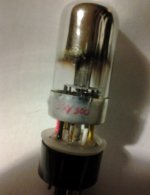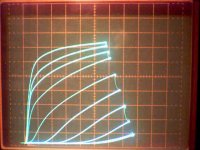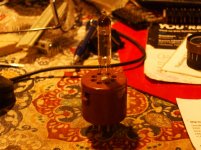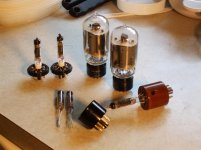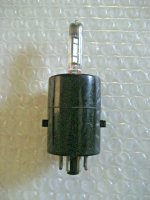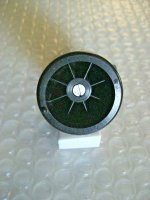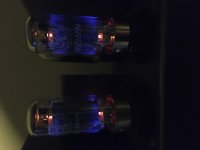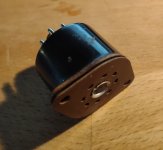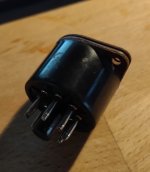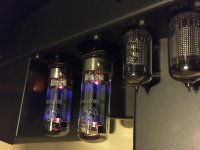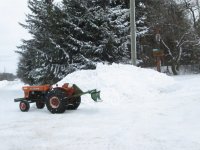9 Pin or 7 Pin plugs and Octals are easy to make using Pins and adapter PCBs off of Ebay. Use a pin straightener, like the one shown below, to hold the pins in place while you solder the adapter PCB to them.
Some of my adapters are pin "programmable" even by use of pin sockets and pin wires.
Now Compactron, Novar and Magnoval plugs are not easy to do, someone needs to sell some adapter PCBs for those, but demand will likely be low.
The PCB adapters are probably not too good for power tubes however, due to the close spacing of the PCB solder pads.
Some of my adapters are pin "programmable" even by use of pin sockets and pin wires.
Now Compactron, Novar and Magnoval plugs are not easy to do, someone needs to sell some adapter PCBs for those, but demand will likely be low.
The PCB adapters are probably not too good for power tubes however, due to the close spacing of the PCB solder pads.
Attachments
Last edited:
I like your spud adaptor! Does it work? What are the Ua, S, mu and current of this “device”?
Well...., all depends on "where" you plug it in. Here are some "FAT" curves for a fat SPUD. (Actually a 6LE8 using grid 3) (could put a tube inside the SPUD though)
Attachments
9 Pin or 7 Pin plugs and Octals are easy to make using Pins and adapter PCBs off of Ebay. Use a pin straightener, like the one shown below, to hold the pins in place while you solder the adapter PCB to them.
Thanks. This is very helpful. I didn’t know for sure the 9 pin PCBs had the inner circle of holes correctly spaced for noval pins.
Could you provide links to your sources for the PCBs and Pins so that I know I get the correct stuff, please.
There are a bunch of venders (in China). Can just search Ebay for "tube adapter PCB". Here is one with a smaller quantity.
4pc CMC 9pin tube socket Adapter bare PCB for EL84 12AX7 6BQ5 ECC83 ECC85 6P14 | eBay
And "tube adapter pins" several vendors.
100pcs normal tube pins for you DIY 12AX7 EL84 6922 12AU7 Tube adapter | eBay
Here is a pin programmable type, already made.
One B9A 9pin CV4035 12AX7 EF86 CV4033 4034 4035 ect Flying pins tube adapter | eBay
Occasionally (not common at all) I have seen these submini tube to Octal ZIF adapters (PIC below) made for tube testers. You push the bar down to grip the wire leads in the socket. Were made by CBS. One member here said he had a box of these from a flea market sale. Maybe would sell one.
One can also use an old Augat round Teflon 8 pin IC socket, wired to an Octal plug, works best for short leaded submini tubes. (2nd PIC below)
4pc CMC 9pin tube socket Adapter bare PCB for EL84 12AX7 6BQ5 ECC83 ECC85 6P14 | eBay
And "tube adapter pins" several vendors.
100pcs normal tube pins for you DIY 12AX7 EL84 6922 12AU7 Tube adapter | eBay
Here is a pin programmable type, already made.
One B9A 9pin CV4035 12AX7 EF86 CV4033 4034 4035 ect Flying pins tube adapter | eBay
Occasionally (not common at all) I have seen these submini tube to Octal ZIF adapters (PIC below) made for tube testers. You push the bar down to grip the wire leads in the socket. Were made by CBS. One member here said he had a box of these from a flea market sale. Maybe would sell one.
One can also use an old Augat round Teflon 8 pin IC socket, wired to an Octal plug, works best for short leaded submini tubes. (2nd PIC below)
Attachments
Last edited:
I wanted to make measured comparisons. I used one of the Pico Technolgy instruments & an HP 334A THD Analyzer. 6BQ7s on that basis almost the equal of the very expensive 6SL7 & 6SN7 . In two different amplifiers with similar 2-stage differential front ends. That has got to make us think.🙂
Or perhaps not. Doesn't look impressive enough for the faithful!😀
Or perhaps not. Doesn't look impressive enough for the faithful!😀
Since you have this "analyzer", and you're near Toronto, have you tried 6N8S/6N9S? If not, I have some you could try.
I thought I had seen some of the Submini/Octal adapter ZIF sockets recently. Found them, but they sold out. Looks like they were made by Sylvania (not CBS) Sylvania EIA code 312 on them. "same as the E104 adapter that came with a TV-7D/U except they are black"
Vacuum Tube Socket ADAPTER TV-7D/U Tester Subminiature 6112 to 8 Pin Octal Vtg | eBay
Ah-ha! I found something similar:
1 x 8 Pin Subminiature Tube To Octal Tube Test Socket Adapter | eBay
Vacuum Tube Socket ADAPTER TV-7D/U Tester Subminiature 6112 to 8 Pin Octal Vtg | eBay
Ah-ha! I found something similar:
1 x 8 Pin Subminiature Tube To Octal Tube Test Socket Adapter | eBay
Attachments
Last edited:
…There are a bunch of venders (in China). Can just search Ebay for "tube adapter PCB". Here is one with a smaller quantity.
Thanks smoking-amp! You pointed me to all the links that I needed to make my own submini to noval adapters. Thanks very much.
I bought some 5B/255M tubes that are on a Loctal, and they work very nicely in my Quad IIs with some adaptors I made. I could buy NOS wafer bases £2, and bakelite octal bases for £1.50.
People here don't like the wafer bases very much, but I have restored a couple of radios from the mid 30's, and the tube bases are all wafer style, and I have not seen a problem with them.
The mistake I made was not checking to see the pin configuration of other Loctal output tubes, e.g. 7C5. The 5B/255M has the same electrode going to different pins, and if I had realised I could have created a more multi-purpose adaptor using common pins.
The other thing to be careful with is the soldering in the octal pins. A hot iron and plenty of solder to guarantee a good joint. I had one tube that worked off and on in my tube tester, and I thought it was the tester that was misbehaving, but it was tracked to a connection that looked OK, but opened up after the tube was inserted with the pushing down force.
People here don't like the wafer bases very much, but I have restored a couple of radios from the mid 30's, and the tube bases are all wafer style, and I have not seen a problem with them.
The mistake I made was not checking to see the pin configuration of other Loctal output tubes, e.g. 7C5. The 5B/255M has the same electrode going to different pins, and if I had realised I could have created a more multi-purpose adaptor using common pins.
The other thing to be careful with is the soldering in the octal pins. A hot iron and plenty of solder to guarantee a good joint. I had one tube that worked off and on in my tube tester, and I thought it was the tester that was misbehaving, but it was tracked to a connection that looked OK, but opened up after the tube was inserted with the pushing down force.
Attachments
Last edited:
Since you have this "analyzer", and you're near Toronto, have you tried 6N8S/6N9S? If not, I have some you could try.
The HP 334A is a tunable rejection filter (Wien Bridge) with a built in analogue voltmeter. There are four different versions starting with the HP 331A. The 334A is the top of the line with auto nulling & an AM detector.
The test frequency is passed thru the Device In Test (Amplifier), the resulting signal fundamental is rejected by the THD Analyzer & the remaining distortion & Noise products measured by the on board VM. Results in % are given.
A filter can be set to remove residuals of noise such as PS, so that only THD is measured.
The THD & Noise Products are available at terminals on the instrument RHS. These can be further analyzed using a scope.
This product line was very popular, we sold many during its lifetime. Still shewing up on the web 4sale today.
The 6N8S & 6N9S look like very good replacements for their American equivalents. Who do you buy from these daze? Its been a while since I've bought anything toob based!🙂
Too damned busy here getting the place ready for Winter. Chains & snow plow gotta be put on the tractor this weekend, a miserable task.😱
Attachments
Last I got them I got 45 6N8S for 100$ CAD shipped. Those were the days...
Still, I find eBay sellers (brandmix19 etc) to be reasonable.
Still, I find eBay sellers (brandmix19 etc) to be reasonable.
- Home
- Amplifiers
- Tubes / Valves
- Homemade tube socket adaptor
